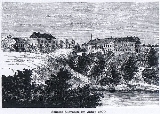
Savoia Castle
Encyclopedia
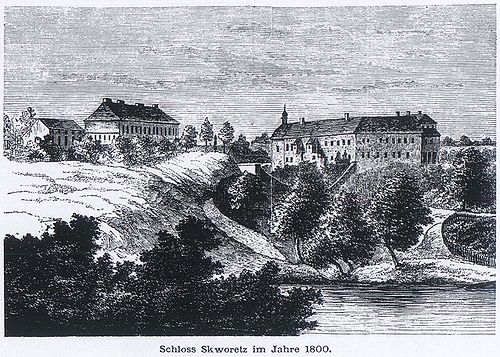
Castle
A castle is a type of fortified structure built in Europe and the Middle East during the Middle Ages by European nobility. Scholars debate the scope of the word castle, but usually consider it to be the private fortified residence of a lord or noble...
near Prague
Prague
Prague is the capital and largest city of the Czech Republic. Situated in the north-west of the country on the Vltava river, the city is home to about 1.3 million people, while its metropolitan area is estimated to have a population of over 2.3 million...
in the Czech Republic
Czech Republic
The Czech Republic is a landlocked country in Central Europe. The country is bordered by Poland to the northeast, Slovakia to the east, Austria to the south, and Germany to the west and northwest....
. It was first mentioned in historical sources in 1279 (but more fully documented in 1404).
Early history
The founder, and maybe the builder too, was probably Domaslav (Domaslaus de Squorz) around 1279, an important courtierCourtier
A courtier is a person who is often in attendance at the court of a king or other royal personage. Historically the court was the centre of government as well as the residence of the monarch, and social and political life were often completely mixed together...
and landed official, the butler of Queen Kunigunda of Slavonia
Kunigunda of Slavonia
Kunigunda Rostislavna was Queen consort of Bohemia and its Regent from 1278 until her death. She was a member of the House of Chernigov, and a daughter of the ruler of Slavonia....
(1262) and her food taster
Food taster
A food taster is a person that takes food to be served to someone else to confirm that it is safe to eat and does not contain toxins or poisons. The person to whom the food is going to be served is usually an important person, like an emperor or monarch, or anyone that could possibly be under...
(1263–1269, 1279), Lord High Treasurer
Lord High Treasurer
The post of Lord High Treasurer or Lord Treasurer was an English government position and has been a British government position since the Act of Union of 1707. A holder of the post would be the third highest ranked Great Officer of State, below the Lord High Chancellor and above the Lord President...
(1267–1278) and one of the ten Burgrave
Burgrave
A burgrave is literally the count of a castle or fortified town. The English form is derived through the French from the German Burggraf and Dutch burg- or burch-graeve .* The title is originally equivalent to that of castellan or châtelain, meaning keeper of a castle and/or fortified town...
s of Prague Castle
Prague Castle
Prague Castle is a castle in Prague where the Kings of Bohemia, Holy Roman Emperors and presidents of Czechoslovakia and the Czech Republic have had their offices. The Czech Crown Jewels are kept here...
. From the castle he built, only the deep well is now preserved, cut in the granite rock, which was situated near to the early gothic palace - that standing on the site of the present school building.
The coat-of-arms
Coat of arms
A coat of arms is a unique heraldic design on a shield or escutcheon or on a surcoat or tabard used to cover and protect armour and to identify the wearer. Thus the term is often stated as "coat-armour", because it was anciently displayed on the front of a coat of cloth...
of Domaslav of Škvorec (three vertical stripes), which cannot be found later in Central Bohemia, proving that the castle must have passed to another noble family
Nobility
Nobility is a social class which possesses more acknowledged privileges or eminence than members of most other classes in a society, membership therein typically being hereditary. The privileges associated with nobility may constitute substantial advantages over or relative to non-nobles, or may be...
not long after. The names of the owners until after 1450 are not now known.
In the second half of 14th century, the castle was owned by the Olbramovic family of Prague. One of them, Olbram son of Menhart (died around 1388), installed the priest of the church in Horky
Hôrky
Hôrky is a village and municipality in Žilina District in the Žilina Region of northern Slovakia.-Geography:The municipality lies at an altitude of 375 metres and covers an area of 2.318 km². It has a population of about 615 people.-External links:...
, which already belonged to Škvorec by 1354. Olbram son of Menhart was from 1356 the Reeve of Prague New Town and in 1373-1380 the Burgrave
Burgrave
A burgrave is literally the count of a castle or fortified town. The English form is derived through the French from the German Burggraf and Dutch burg- or burch-graeve .* The title is originally equivalent to that of castellan or châtelain, meaning keeper of a castle and/or fortified town...
of Vyšehrad
Vyšehrad
Vyšehrad is a castle located in the city of Prague, Czech Republic. It was probably built in the 10th century, on a hill over the Vltava River...
. In connection with Škvorec he is mentioned only two times: first as Olbram of Škvorec (in Skworzecz) in the records of visitation of the Prague archdeacon Pavel of Janovice from 1380, and as Olbram son of Menhart of Škvorec a document from 1385 (de Skworecz).
After his death, his three sons Olbram, Pavel and Václav became the owners of Škvorec. The most important of them was Olbram: in 1377 he started to study at the Faculty of Law of Prague University
Charles University in Prague
Charles University in Prague is the oldest and largest university in the Czech Republic. Founded in 1348, it was the first university in Central Europe and is also considered the earliest German university...
. In 1379 he became the canon of Prague and Vyšehrad. Between 1389-1396 he was the provost of St.Apolinar in Prague New Town, and also the chancellor of the king’s brother Jan of Zhořelec
Görlitz
Görlitz is a town in Germany. It is the easternmost town in the country, located on the Lusatian Neisse River in the Bundesland of Saxony. It is opposite the Polish town of Zgorzelec, which was a part of Görlitz until 1945. Historically, Görlitz was in the region of Upper Lusatia...
. On 31 January 1396, he became the Archbishop of Prague (he was installed by Pope Boniface IX
Pope Boniface IX
Pope Boniface IX , born Piero Tomacelli, was the second Roman Pope of the Western Schism from November 2, 1389, until October 1, 1404...
.). His brother Pavel was a Burgrave
Burgrave
A burgrave is literally the count of a castle or fortified town. The English form is derived through the French from the German Burggraf and Dutch burg- or burch-graeve .* The title is originally equivalent to that of castellan or châtelain, meaning keeper of a castle and/or fortified town...
in Týn nad Vltavou
Týn nad Vltavou
Týn nad Vltavou is a town in the South Bohemian Region of the Czech Republic. It has approximately 8,200 inhabitants.- Main sights :* main square* St. Jacob's church* town hall* town museum, expositon of moldavite stones* ruins of Tyn's castle...
(1397), and Václav earned 500 marks of silver in the king’s service in 1396. These successes of the three brothers had an influence on their building activity at Škvorec, because its early gothic castle didn’t conform to the needs of noblemen at the end of 14th century.
According to the archeological, historical and building research made by architect J. Žižka, it appears that round 1400 the family of Olbramovic essentially enlarged the area of the castle and added to the buildings. Opposite the old early-gothic palace they built an oblong tower
Tower
A tower is a tall structure, usually taller than it is wide, often by a significant margin. Towers are distinguished from masts by their lack of guy-wires....
with a pointed-arched gate and with a small wicket, together with drawbridge
Drawbridge
A drawbridge is a type of movable bridge typically associated with the entrance of a castle surrounded by a moat. The term is often used to describe all different types of movable bridges, like bascule bridges and lift bridges.-Castle drawbridges:...
s across the newly dug water-filled moat
Moat
A moat is a deep, broad ditch, either dry or filled with water, that surrounds a castle, other building or town, historically to provide it with a preliminary line of defence. In some places moats evolved into more extensive water defences, including natural or artificial lakes, dams and sluices...
. Above it, east of the entrance tower, they built another gothic palace with a chapel, whose chaplain called Václav is noted in judgment roll of the Archbishopric of Prague in 1404. Due to the building of the new palace, Škvorec thus had two palaces, as was faithfully recorded in the fideicommissum documents in 1654.
The archbishop with his two brothers owned Škvorec castle until 2 May 1402, when he died. His two surviving brothers then divided the property amongst themselves. Next, Jan Nichilen of Prague bought the Václav’s share (the rent from Škvorec Castle, half of the farmyard and some villages) in 1411, and before 1418 the owner of it was Jan of Klučov. The second half of property was still owned by Pavel of Škvorec until his death (after 1418).
His widow Eliška (Elisabeth) married before 1422 Jan Ohnništko of Ohnišťany, who appropriated the second half of the property too. But in 1426 he violated the parliamentary peace, when he killed his ex-neighbor Prokop Trčka of Květnice in a duel in Prague. As a result he was brought to court and then executed. Eliška became a widow again and very soon she had big debts. Because of them, she had to sell the rent from Škvorec, Hostyň and the half of the market-town of Úvaly to Prokop Bervík of Malešice in the same year. But he sold it only a short time after to Vilém of Kounic, from whom it was bought by Petřík Olbrámovic (shortly called Olbrámek), and thanks to this the whole property was again owned by the family of Olbramovic of Prague.
Early modern history
The next important owner of Škvorec castle was Čeněk of Klinštejn the Crown Prosecutor, who bought it from the Olbramovic family in 1462. He was a very significant person in the BohemiaBohemia
Bohemia is a historical region in central Europe, occupying the western two-thirds of the traditional Czech Lands. It is located in the contemporary Czech Republic with its capital in Prague...
of that time. He was not only the Crown Prosecutor, but also a Burgrave of Prague Castle (1451–1461) and of Vyšehrad
Vyšehrad
Vyšehrad is a castle located in the city of Prague, Czech Republic. It was probably built in the 10th century, on a hill over the Vltava River...
(1467–1479) and in the years 1457-1481 he was the Queen's Prosecutor. In the time of his son Jan, in 1497, King Vladislas II of Hungary made Škvorec into a market-town. After his death round 1509, his brother Zdeněk inherited the castle. He had many law-suits with his neighbours, townsmen and also with his nearest relatives, as did his son Jindřich, who died in the battles against the Turks in Hungary. After that, the Castle passed to brother of Jindřich's mother - Zikmund Smiřický of Smiřice. In about 1545 he started reconstructing the old castle and modernised it into a renaissance
Renaissance
The Renaissance was a cultural movement that spanned roughly the 14th to the 17th century, beginning in Italy in the Late Middle Ages and later spreading to the rest of Europe. The term is also used more loosely to refer to the historical era, but since the changes of the Renaissance were not...
seat. During this reconstruction he probably built the western range with arcade
Arcade (architecture)
An arcade is a succession of arches, each counterthrusting the next, supported by columns or piers or a covered walk enclosed by a line of such arches on one or both sides. In warmer or wet climates, exterior arcades provide shelter for pedestrians....
s and the building on the eastern side of the courtyard.
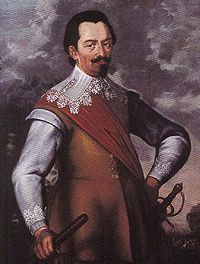
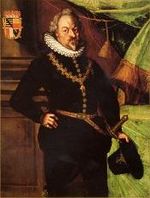
As the fideicommissum records from 1618 tell, Albrecht Jan Smiřický of Smiřice had a vaulted hall known as “the stone hall”, lord’s apartment and also an armoury built in the castle. In other parts of the castle there were offices and rooms of the members of his estate government and on the ground floor there was some economic establishment.
During the confiscation of his property in 1621, Škvorec Castle fell into the hands of Albrecht of Valdštejn
Albrecht von Wallenstein
Albrecht Wenzel Eusebius von Wallenstein , actually von Waldstein, was a Bohemian soldier and politician, who offered his services, and an army of 30,000 to 100,000 men during the Danish period of the Thirty Years' War , to the Holy Roman Emperor Ferdinand II...
because his mother was from the Smiřický family. He sold it to Karl of Lichtenstein
Karl I of Liechtenstein
Karl I, Prince of Liechtenstein was the first Liechtenstein to become the Prince of Liechtenstein, thus he was the founder of the Princely Family of Liechtenstein....
in 1623.
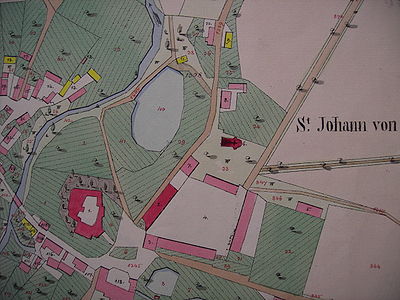
The preserved records of the 'hejtman' of Černý Kostelec, Captain Přech Svatkovský of Dobrohošť, shows that the Swedes plundered the castle and set it on fire on the 27th November 1639. During the fire the ceilings in some rooms in both palaces collapsed (in one of them – in the upper palace – was the jail for the retainers in that time). The repair works appear to have been minimal: until 1654 only the upper palace was covered by a temporary thatched roof
Thatching
Thatching is the craft of building a roof with dry vegetation such as straw, water reed, sedge , rushes, or heather, layering the vegetation so as to shed water away from the inner roof. It is a very old roofing method and has been used in both tropical and temperate climates...
and no more reconstruction then continued. So for the rest of 17th century the Castle was known as a ruin.
From the records of the Uhříněves Estate (to which Škvorec belonged at that time) it is known that the first part of the Castle was repaired by Kristian Minedi in 1710, when he submitted accounts for repairing six rooms to the Estate government. This northern part of the castle became the seat of Princess Maria Theresa
Marie Terezie Savojská
Maria Theresia of Liechtenstein was the heiress to the Dukedom of Troppau Silesia . Countess of Soissons by marriage, she was the last person to hold the title. She had one son who predeceased her in 1734...
of Savoy, born of Lichtenstein (died 1772) after 1729.
Later modern history
Škvorec Castle was still habitable in 1794, but in the years that followed it started to decay again. Instead of reconstruction, the Castle was largely dismantled in 1860-1884.The dilapidated northwestern range of the old castle was demolished first, then the western two-storied wing was taken down in 1883.On the site of the ruin of the old gothic palace, the local school was built in 1890. Of the whole castle only the rebuilt baroque
Baroque
The Baroque is a period and the style that used exaggerated motion and clear, easily interpreted detail to produce drama, tension, exuberance, and grandeur in sculpture, painting, literature, dance, and music...
southeastern part with the gatehouse tower was left, and also the old Castle well in the courtyard.
The so-called 'New Castle' stands opposite the old one. It comprises a large baroque one-storey building with a courtyard of farm buildings, the remains of an old fountain and a baroque gate. As the plans of the architect Josef Jägr from the Lichtenstein family archive in Vaduz testify, this new part of Škvorec Castle was built soon after 1791.
- 1923 - 2008 - Czechoslovak state property
- Listed landmark since 1958
- 2008 - Property of SalvatoreSavellithumb|300px|The Coat of Arms of the Savelli over a wall of the church of [[Santa Maria in Aracoeli]], [[Rome]].The Savelli were a rich and influential Roman aristocratic family who rose to prominence in the 13th century and became extinct in the main line with Giulio Savelli .The family, who held...
-Eremeev family. - Reconstruction has started in 2008
Sources
- Liechtenstein — A Modern History by David Beattie CMGOrder of St Michael and St GeorgeThe Most Distinguished Order of Saint Michael and Saint George is an order of chivalry founded on 28 April 1818 by George, Prince Regent, later George IV of the United Kingdom, while he was acting as Prince Regent for his father, George III....
, London, 2004, ISBN 1-85043-459-X.

